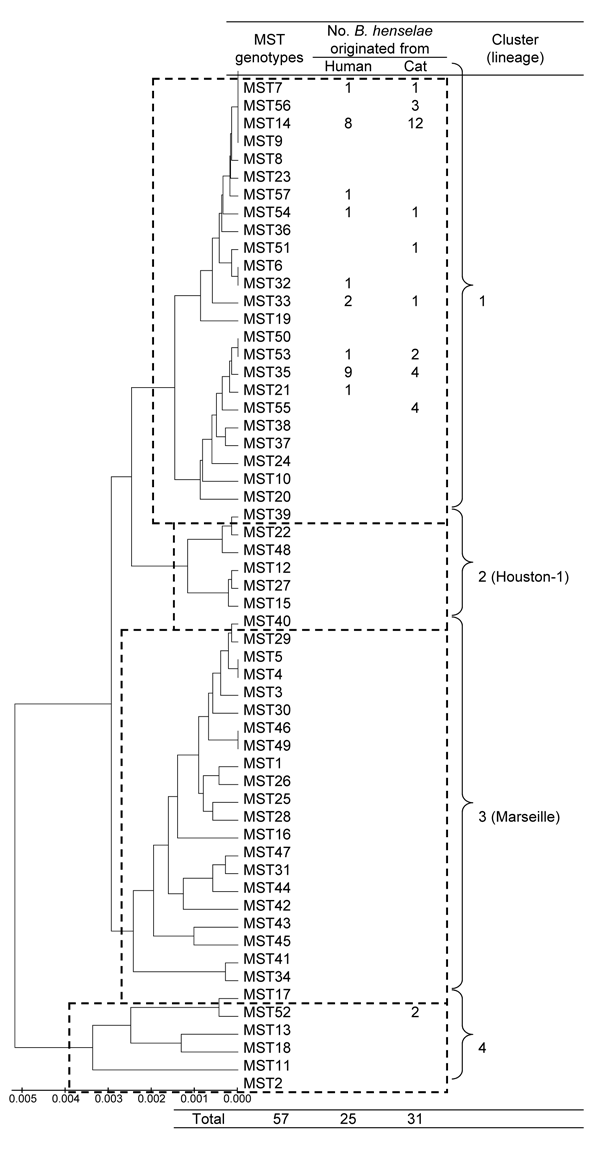Volume 16, Number 12—December 2010
Dispatch
Multispacer Typing of Bartonella henselae Isolates from Humans and Cats, Japan
Figure

Figure. Phylogeny and clusters of multispacer typing (MST) genotypes of Bartonella henselae isolates from humans and cats, Japan, based on 9 concatenated intergenic spacer sequences in 57 MST genotypes. The unweighted pair-group method with arithmetic mean method in MEGA4 software (12) was used for phylogenetic analysis. Dotted rectangles show 4 clusters of MST genotypes, 2 of which correspond to the B. henselae Houston-1 and Marseille type strains. Scale bar indicates nucleotide substitutions per site.
References
- Anderson BE, Neuman MA. Bartonella spp. as emerging human pathogens. Clin Microbiol Rev. 1997;10:203–19.PubMedGoogle Scholar
- Boulouis HJ, Chang CC, Henn JB, Kasten RW, Chomel BB. Factors associated with the rapid emergence of zoonotic Bartonella infections. Vet Res. 2005;36:383–410.PubMedGoogle Scholar
- Maruyama S, Nakamura Y, Kabeya H, Tanaka S, Sakai T, Katsube Y. Prevalence of Bartonella henselae, Bartonella clarridgeiae and the 16S rRNA gene types of Bartonella henselae among pet cats in Japan. J Vet Med Sci. 2000;62:273–9.PubMedGoogle Scholar
- Li W, Raoult D, Fournier PE. Bacterial strain typing in the genomic era. FEMS Microbiol Rev. 2009;33:892–916.PubMedGoogle Scholar
- Li W, Chomel BB, Maruyama S, Guptil L, Sander A, Raoult D, Multispacer typing to study the genotypic distribution of Bartonella henselae populations. J Clin Microbiol. 2006;44:2499–506.PubMedGoogle Scholar
- Li W, Raoult D, Fournier PE. Genetic diversity of Bartonella henselae in human infection detected with multispacer typing. Emerg Infect Dis. 2007;13:1178–83.PubMedGoogle Scholar
- Tsuneoka H, Yanagihara M, Otani S, Katayama Y, Fujinami H, Nagafuji H, A first Japanese case of Bartonella henselae induced endocarditis diagnosed by prolonged culture of a specimen from the excised valve. Diagn Microbiol Infect Dis. 2010;68:174–6.PubMedGoogle Scholar
- Yanagihara M, Tsuneoka H, Hoshide S, Ishido E, Umeda A, Tsukahara M, Molecular typing of Bartonella henselae DNA extracted from human clinical specimens and cat isolates in Japan. FEMS Immunol Med Microbiol. 2010;60:44–8.PubMedGoogle Scholar
- Jensen WA, Fall MZ, Rooney J, Kordick DL, Breitschwerdt EB. Rapid identification and differentiation of Bartonella species using a single-step PCR assay. J Clin Microbiol. 2000;38:1717–22.PubMedGoogle Scholar
- Anderson B, Sims K, Regnery R, Robinson L, Schmidt MJ, Goral S, Detection of Rochalimaea henselae DNA in specimens from cat scratch disease patients by PCR. J Clin Microbiol. 1994;32:942–8.PubMedGoogle Scholar
- Bergmans AM, Schellekens JF, van Embden JD, Schouls LM. Predominance of two Bartonella henselae variants among cat-scratch disease patients in the Netherlands. J Clin Microbiol. 1996;34:254–60.PubMedGoogle Scholar
- Tamura K, Dudley J, Nei M, Kumar S. MEGA4: Molecular Evolutionary Genetics Analysis (MEGA) software version 4.0. Mol Biol Evol. 2007;24:1596–9.PubMedGoogle Scholar
- Regnery R, Martin M, Olson J. Naturally occurring “Rochalimaea henselae” infection in domestic cat. Lancet. 1992;340:557–8.PubMedGoogle Scholar
- Arvand M, Feil EJ, Giladi M, Boulouis HJ, Viezens J. Multi-locus sequence typing of Bartonella henselae isolates from three continents reveals hypervirulent and feline-associated clones. PLoS ONE. 2007;2:e1346.PubMedGoogle Scholar
- Bouchouicha R, Durand B, Monteil M, Chomel BB, Berrich M, Arvand M, Molecular epidemiology of feline and human Bartonella henselae isolates. Emerg Infect Dis. 2009;15:813–6.PubMedGoogle Scholar
Page created: August 29, 2011
Page updated: August 29, 2011
Page reviewed: August 29, 2011
The conclusions, findings, and opinions expressed by authors contributing to this journal do not necessarily reflect the official position of the U.S. Department of Health and Human Services, the Public Health Service, the Centers for Disease Control and Prevention, or the authors' affiliated institutions. Use of trade names is for identification only and does not imply endorsement by any of the groups named above.